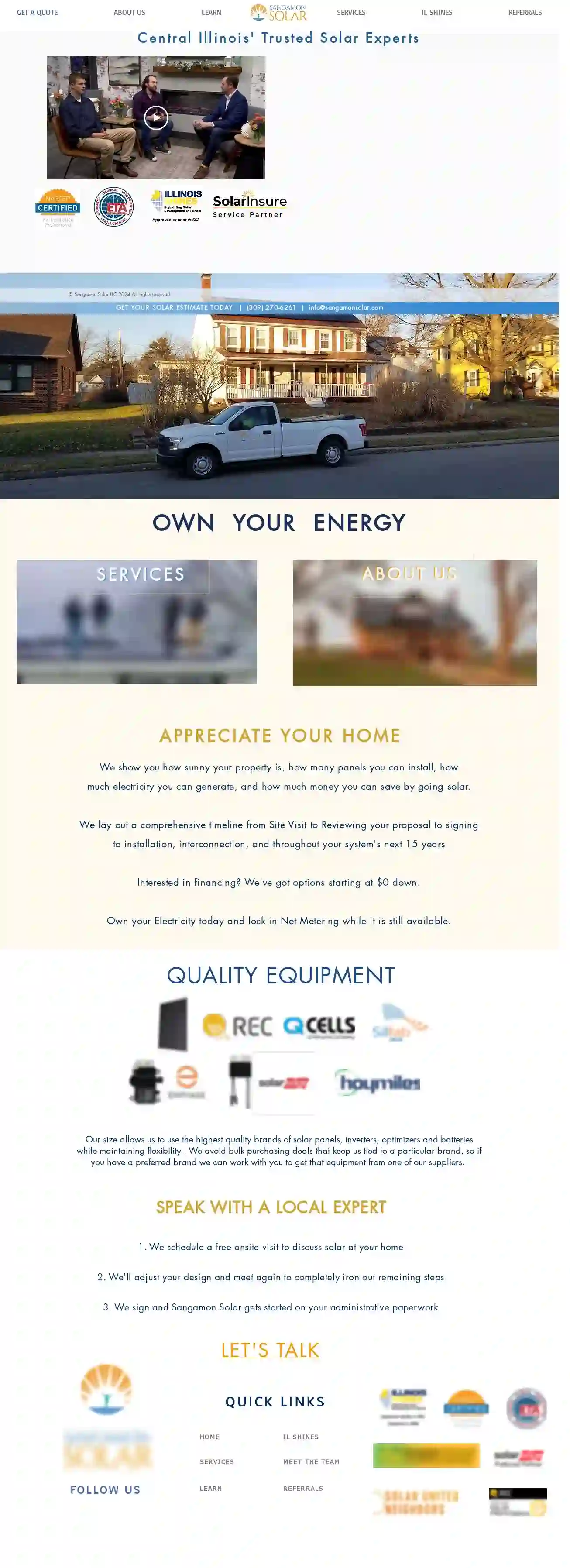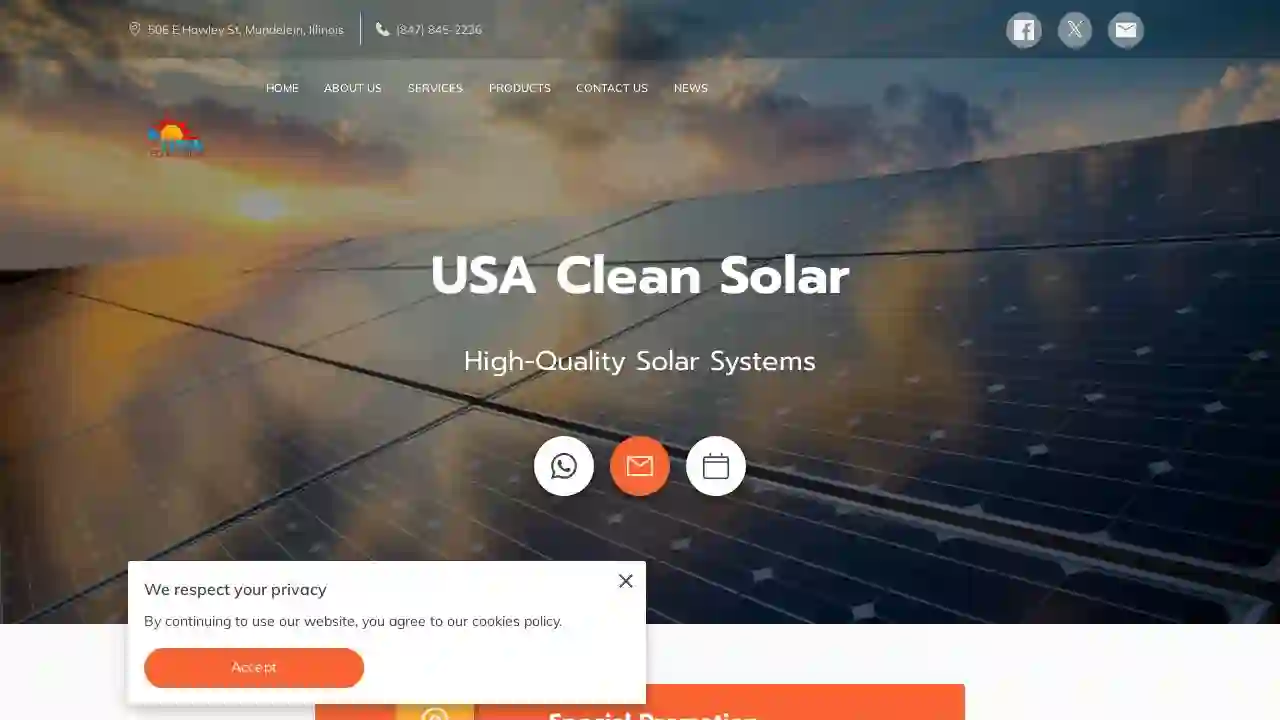Solar Installers Kewanee
Top Local Solar Installers in Kewanee
Get 3 FREE Solar Installation Company quotes for your project today! Compare profiles, reviews, accreditations, portfolio, etc... and choose the best offer.

FreeWorld Solar
538 reviewsSuite 100, Chicago, IL, 123 Solar Street, 60601, USFreeWorld Solar is a leading provider of solar energy solutions in Chicago and surrounding areas. Our team of experts is dedicated to helping property owners save money on electricity by harnessing the power of the sun. We offer a range of services including solar panel installation, battery storage, EV chargers, commercial development, and solar financing and leasing. Our goal is to make solar energy accessible to all, which is why we provide free estimates and flexible financing options while helping you find applicable tax incentives and rebates.
- Services
- Why Us?
- Accreditations
- Our Team
- Testimonials
- Gallery
Get Quote
The Solar Soldier
520 reviews444 West Lake Street, Suite 1700, Chicago, 60606, USThe Solar Soldier is a veteran-owned business dedicated to providing comprehensive solar solutions tailored to meet your energy needs. Our mission is to lead in the adoption of clean energy by providing consulting services and solar designing tailored to each client's unique needs. We offer a wide range of services including solar + roof installations, EV Charger, service panel upgrades, and more.
- Services
- Why Us?
- Accreditations
- Our Team
- Testimonials
- Gallery
Get Quote
Solar Professionals of Illinois
514 reviews4137 Sauk Trail, Suite #333, Richton Park, 60471, USSolar Professionals of Illinois is a solar energy sales company based in Richton Park Illinois, serving the northeast part of the state. Absolutely free of cost, or compromises, call us or contact us to have your home evaluated for solar power. No out-of-pocket cost and start saving from the first day your solar panels are installed. You will change from an expense of an electric bill to an investment in solar panels because they increase the value of your home. We are a local company so we always answer your concerns in person.
- Services
- Why Us?
- Accreditations
- Our Team
- Testimonials
- Gallery
Get Quote
Sangamon Solar
54 reviewsN/A, USCentral Illinois' Trusted Solar Experts. Sangamon Solar LLC helps you own your electricity by providing comprehensive solar solutions including site visits, proposal reviews, installation, and more. We offer high-quality equipment and flexible financing options starting at $0 down. Lock in Net Metering today.
- Services
- Why Us?
- Accreditations
- Our Team
- Testimonials
- Gallery
Get Quote
Illinois Solar Express, LLC
530 reviews3rd Floor, Oakbrook Terrace, 1 Mid America Plaza, 60181, USIllinois Solar Express is a leading solar company in Illinois, providing sustainable and reliable energy solutions for homes. They offer long-term solar benefits, including facilitating the transition to sustainable solar energy, providing all necessary services for solar installation, and ensuring customer satisfaction through professional service and follow-up.
- Services
- Why Us?
- Accreditations
- Our Team
- Testimonials
- Gallery
Get Quote
WindSoleil Solar and Wind Energy Services
4.642 reviews401 N. Trumbull Ave Ste D, N/A, Chicago, 60624, USWindSoleil provides Solar and Wind Energy Installation Services in Illinois for home and businesses, Solar Panels, Wind Turbines, Off-Grid Kits, Portable Solar Chargers, etc, Worldwide.
- Services
- Why Us?
- Accreditations
- Our Team
- Testimonials
- Gallery
Get Quote
USA Clean Solar
11 reviews506 E Hawley St, Mundelein, Illinois, 60060, USUSA Clean Solar is a family-owned business based in Mundelein, Illinois, providing high-quality solar panel installations for both residential and commercial sectors. They offer cost-effective components and premium installation services tailored to meet specific customer needs. Their team of highly motivated and knowledgeable solar panel installers ensures efficient service and high-quality products.
- Services
- Why Us?
- Gallery
Get Quote
Selenium Solar
Selenium Energy, LLC., Olympia Fields, IL 60461, IL, 60461, USSelenium Solar Energy is a locally based Illinois solar company dedicated to providing renewable energy solutions to residential, commercial, and government sectors. With a commitment to customer satisfaction, they offer services that cater to the needs of their clients, ensuring that they receive the best possible experience. Their team consists of skilled, NABCEP-certified professionals who are dedicated to providing top-notch service.
- Services
- Why Us?
- Accreditations
- Gallery
Get Quote
RxSun
4.878 reviewsSuite 100, Chicago, IL, 123 Solar Street, 60601, USRxSun is a full service residential solar company helping homeowners throughout Illinois, Michigan, Wisconsin, and Florida. Our NABCEP certified professionals are here to walk you through every step of the process, from design to installation to savings.
- Services
- Why Us?
- Accreditations
- Our Team
- Testimonials
- Gallery
Get Quote
Sun Collectors
5222 reviews4507 N Sterling Ave #400, Peoria, 61615, USSun Collectors is a professional solar energy installation and service provider offering residential, commercial, and agricultural solar solutions. With a focus on customer satisfaction and quality service, they aim to make the process of switching to solar energy easy and hassle-free. Their team of experts is dedicated to providing exceptional customer service and ensuring that clients receive the best possible experience.
- Services
- Why Us?
- Accreditations
- Our Team
- Testimonials
- Gallery
Get Quote
Over 4,210+ Solar Installers on our directory
Our solar installers operate in Kewanee & beyond!
SolarCompaniesHub has curated and vetted Top Solar Businesses near Kewanee. Find a reliable pro today.
Frequently Asked Questions About Solar Installers
- System size (measured in kilowatts, or kW)
- Type of solar panels (monocrystalline, polycrystalline, thin-film)
- Roof complexity (pitch, size, obstructions)
- Labor costs in your area
- Available incentives and rebates
- Cash Purchase: The most straightforward option, providing the greatest long-term savings but requiring a larger upfront investment.
- Solar Loans: Loans specifically designed for solar installations, often with favorable terms and interest rates.
- Solar Leases: A third-party company owns the system and leases it to you, allowing you to go solar with little or no upfront cost, but you won't own the system or receive tax benefits.
- Power Purchase Agreements (PPAs): Similar to leases, but you pay for the electricity generated by the system, not the system itself.
- Home Equity Loans or Lines of Credit: Borrow against the equity in your home.
- Your current energy usage
- The size of your solar system
- Your local electricity rates
- The amount of sunlight your panels receive
- Available net metering policies
What happens if my roof needs to be replaced after I install solar panels?
What is the average cost of solar panel installation in USA?
How can I finance my solar panel installation?
How much can I save on my electricity bill with solar panels?
What happens if my roof needs to be replaced after I install solar panels?
What is the average cost of solar panel installation in USA?
- System size (measured in kilowatts, or kW)
- Type of solar panels (monocrystalline, polycrystalline, thin-film)
- Roof complexity (pitch, size, obstructions)
- Labor costs in your area
- Available incentives and rebates
How can I finance my solar panel installation?
- Cash Purchase: The most straightforward option, providing the greatest long-term savings but requiring a larger upfront investment.
- Solar Loans: Loans specifically designed for solar installations, often with favorable terms and interest rates.
- Solar Leases: A third-party company owns the system and leases it to you, allowing you to go solar with little or no upfront cost, but you won't own the system or receive tax benefits.
- Power Purchase Agreements (PPAs): Similar to leases, but you pay for the electricity generated by the system, not the system itself.
- Home Equity Loans or Lines of Credit: Borrow against the equity in your home.
How much can I save on my electricity bill with solar panels?
- Your current energy usage
- The size of your solar system
- Your local electricity rates
- The amount of sunlight your panels receive
- Available net metering policies